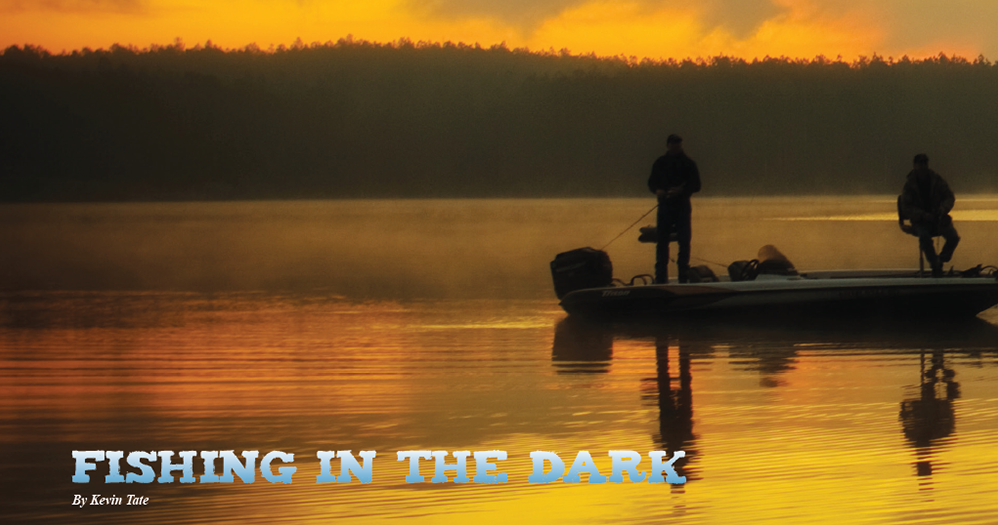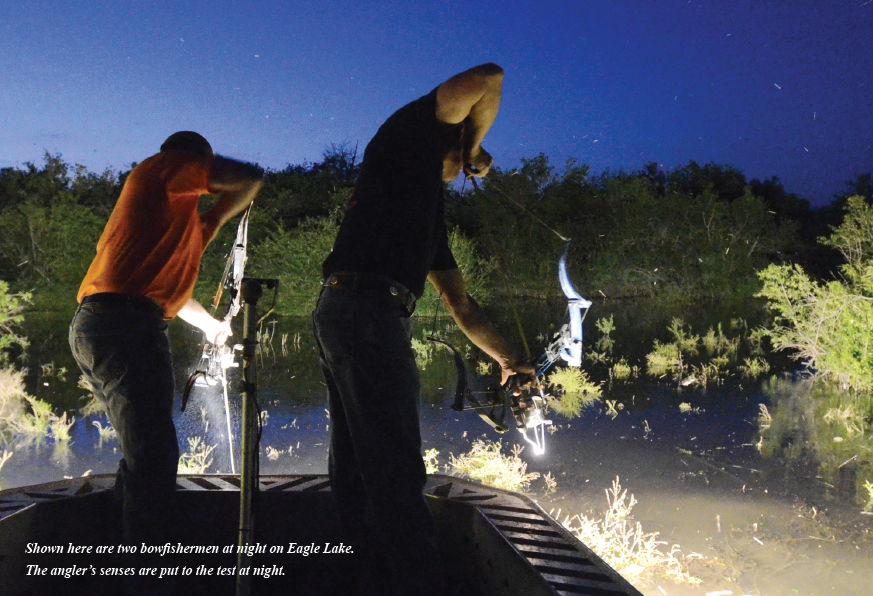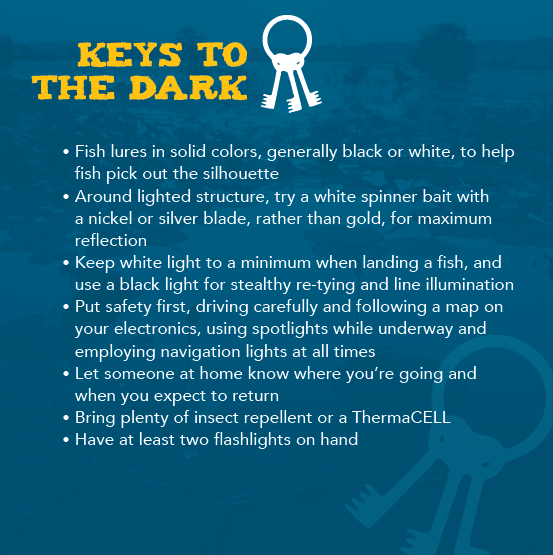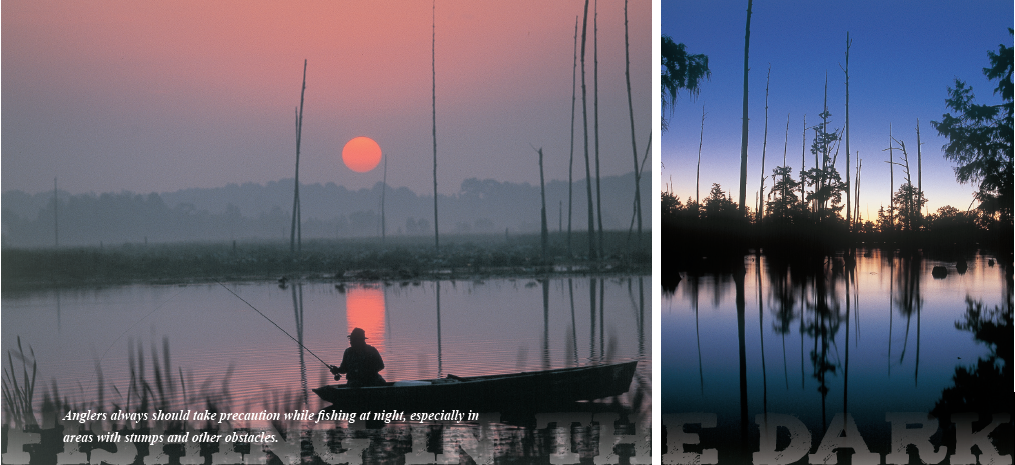Mississippi Outdoors: Fishing in the Dark
7/12/2017 12:54:06 PM
By Kevin Tate

The cool of the evening can be a hot time for bass fishing
Summer crowds on Mississippi’s open waters are often a turnoff to anglers and, it turns out, to big bass as well.
For those looking to find new opportunities, the question can be more of when than where. Chasing largemouth bass at night is a chance to play a brand new game on the same familiar field.
Changing techniques to a nocturnal base primarily involves lure pattern and color choices, line and light equipment choices, and a calm, steady dedication to safety.
“You can fish the same places at night you’d fish during the day, and pull in a little shallower even,” says Clay Coleman, of Clay’s Bait and Tackle, in Tupelo. “The bass feed up shallower at night.”
Coleman is a lifelong fisherman and his business keeps him tapped into the brain trust of north Mississippi’s best and most avid bass enthusiasts.
“Most of the guys I know are beating the banks and boat docks and gravel bars, fishing fairly shallow around anything with a light on it,” he said.
Deep water structures, especially any holding treetops or other vegetation, are outstanding night spots as well.
At night, bass hunt by spotting their prey’s silhouettes. Solid, dark lures are easier to silhouette, so in situations where no flash is available, black lures prevail. The opposite holds true in areas where some light (either from a boat dock or a bright moon) can come into play. Especially on a full moon night, a solid white bait can work even better than a solid black bait for silhouetting and being visible to the fish.
“I used to throw a big black spinnerbait with a big black blade,” Coleman said of his own night fishing adventures. “I’ve gone to a big white spinnerbait with a silver blade, especially if I’m throwing it around boat docks or around anything with a light. That silver reflects the light better than the black or gold blades, and it is going to flash better under water. There is absolutely a time for a straight up white bait or chartreuse, and when lights are shining is that time.
“On a dark, black night with no moon, black is it: black, black and purple, black and red, black and blue, (and) black and hot pink. Those colors seem to hold up best.”
Along with sight, Coleman has found scent to be a critical factor for success.
“All of their senses are in play at night,” he said, “and I’ve had it proven to me that scent matters at night. I was fishing in the same boat with a friend, same equipment, same worm, same everything. I’d sold him the gear he was using and I was using exactly the same thing, and he was getting strikes left and right and I hadn’t had one. We were working the same structure so it wasn’t a matter of him being on the front of the boat and getting to the aggressive fish first. I was changing lures, changing worms, trying to figure out why I wasn’t getting a strike, until he finally tore up the worm he was using. He opened his bag to replace it and the garlic wave that rolled out nearly knocked me off the boat. I took my worm off, put one of his on, cast and immediately caught a fish, then caught fish consistently right along with him the rest of the night. Scent absolutely matters at night.”

Shown here are two bow fishermen at night on Eagle lake. The angler's sense are put to the test at night.
The angler’s senses, especially sight, also are put to the test at night. The use of light can be a key factor in night fishing.
“You’ve got to have navigation lights on for safety, but those lights are pretty dim and the fish aren’t going to see that,” Coleman said, “but if you’ve got some kind of a bright spotlight on or a headlamp on as you’re bringing a fish to the boat, it will absolutely freak them out as they’re coming up to it.”
Black lights, on the other hand, are a true godsend and wonder.
“A black light is wonderful to have, and there are a ton of options out there,” Coleman said. “There are some you can stick on your boat, there are some that are made onto the boat, some that you can permanently attach, some that stick on with suction cups, and the black lights do not seem to spook fish as they’re coming up to them.

“Now, most of the black lights have a fluorescent light on the back of them, and if you kick that on, man, that helps you tie your bait on. And, besides, it helps to have a headlamp on when you’re re-tying, but if you’re trying to land a fish with a light on, man, that’s no good at all. You’re about to freak some fish out and it’s really hard to land them. Especially a good spotted bass, a light really freaks them out. So if you can boat flip them or get them in a net before you start turning lights on, that’ll really help, but a black light is just wonderful.”
Beyond the black light’s gentle illumination, it makes monofilament line fluoresce, a vital asset when seeing the line in the water is important.
“Most guys are using just monofilament clear blue fluorescent, and now there are a couple fluorocarbons that will glow in a black light. P-Line CX is a copolymer. It’s a monofilament base with a fluorocarbon coating, and it is also black light visible. You turn a black light on, and the line looks like a neon sign going out into the water. That really helps if you’re on a slow bite, or if you’re throwing a big black and blue jig or a big black and blue worm.
“With a spinnerbait, it’s not as critical because usually you’ll be throwing a spinnerbait around docks that already have light. Gravel bars, big wide-open places like that where you can see … it’s not as necessary to see that line to know the bite is there when you’re fishing a spinnerbait. But if it’s a slow bite, a touch-critical thing … that black light is gold.”
One more key technique involves one of the most exciting practices bass fishing has to offer: top-water action. The baits day anglers restrict to very early and very late are good to go all night long. “A big, black buzz bait or an old-school, black Jitterbug, by Arbogast, you can even get the jointed ones, those things are money at night,” Coleman said. “You can throw a buzzbait all night long. The Whopper Plopper, by River2Sea, is one you can work even slower. It still has that buzzbait sound, but it’s a solid body and the fish can target it better. It’s still dark, but from in the water looking up, they can still see it. You’re using a black silhouetted bait they’ll be able to see. That should be out of sight for a night bait.”
Besides the techniques, additional attention to the details of safety is vital. Night anglers should take extra care while underway. If there are fishing areas with stumps or other commonly encountered obstacles, they should follow carefully laid plans for entry and exit, following a trail marked on their electronics and exercising extreme caution at all times. Each boat should have at least two flashlights, along with plenty of insect repellent, and someone at home should know where they have gone and when they can be expected to return.

Anglers always should take precaution while fishing at night, especially in areas with stumps and other obstacles.









